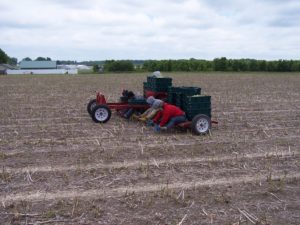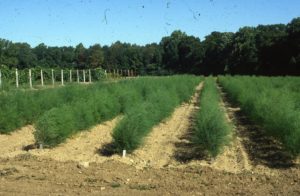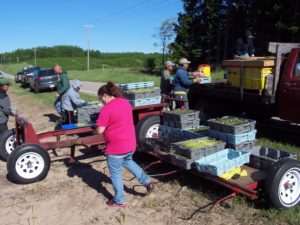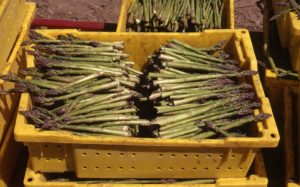Registration of the herbicide clomazone through the IR-4 Project offers asparagus growers another weed management tool.
Even as the consumption of asparagus by US consumers has steadily increased, the amount of domestic production continues to decline. US per capita consumption of asparagus increased from 0.8 pounds in 1980 to nearly 1.6 pounds in 2017. According to USDA, most of the asparagus consumed by Americans is provided by imports, which increased from 11 percent in 1980 to 91 percent in 2015.

Most US commercial asparagus production occurs in Michigan, California, Washington and New Jersey. According to USDA, 22,900 acres of asparagus were planted in 2018, down nearly 5,000 acres from the previous year. US farmers produced 7,852 tons of asparagus in 2018, down from 9,307 tons in 2017.
Ag Marketing Resource Center reported that US acreage of asparagus is about one-third of what it was 15 years ago due to increased imports from Central and South America. In 2017 about 502 million pounds of fresh asparagus was imported, mostly from Mexico, Peru and Chile.
An expensive crop to produce
Asparagus is a perennial crop that is normally planted in the spring. During the first year the plants are allowed to grow and no harvesting usually occurs. In the second year plants come up and grow and spears may be harvested for two weeks. During the third and subsequent years spears are harvested for six to eight weeks with 22-25 pickings per season. An asparagus planting is normally maintained for 12-15 years.
“Asparagus is an expensive crop to produce because it has to be harvested every other day for six to eight weeks,” said horticulture professor and weed scientist Bernard Zandstra at Michigan State University. “Growers do not normally till asparagus fields. Perennial weeds tend to develop in perennial crops because the soil is not tilled. Herbicides are used to control the weeds.

“Herbicides are needed to suppress annual and perennial grasses and broadleaf weeds throughout the asparagus production season. Asparagus growers need several herbicides to control different weeds. By applying herbicides with different modes of action, growers are able to control most annual weeds and avoid resistance to the herbicides.”
Zandstra said current asparagus hybrids produce 2,500-3,000 or more pounds per acre.
“These hybrids produce good yields with optimum crop management,” he said. “A vigorous planting produces maximum yields from years four to 10 and then the yields start to decline.”
Zandstra said when an asparagus planting is removed from a field, most growers do not immediately replant a new asparagus crop.
“It is recommended that growers plant another crop such as corn, soybeans, cabbage, carrots, pumpkins or squash after asparagus,” he said. “They should plant something different for three to five years to allow the asparagus crop residues to break down. If growers replant asparagus within two years, there can be a suppression of the new growth caused by the breakdown of the old roots and plant tissue.”
Expanding herbicide options
Zandstra is constantly looking for and testing herbicides that can be applied to vegetable crops.

“I have conducted field trials for weed control efficacy and crop safety of the pre-emergent herbicide clomazone on asparagus for over 10 years,” he said. “I found that clomazone helped control several serious weeds. It has a mode of action different from any of the other herbicides that the asparagus growers are using. Clomazone fits the asparagus growers’ needs.”
Field sandbur and large crabgrass are two serious weedy grasses that clomazone suppresses quite well. It also suppresses some serious broadleaf weeds, including common lambsquarters, common groundsel and common ragweed, which are often found in asparagus fields.
“I saw the advantages of using clomazone and spoke with the growers as I was doing the trials,” Zandstra said. “They saw the potential benefits of having clomazone registered for use on asparagus. I submitted a project clearance request (PCR) to IR-4 to expand clomazone label to include asparagus.”
Zandstra was asked by IR-4 to conduct the clomazone residue field study trials on asparagus. The studies were done at research stations in Oceana County and on the Michigan State University campus in East Lansing,
Need for good weed management

Zandstra said a high degree of weed control is important with asparagus to control germinating weeds.
“Asparagus growers need to have access to a variety of herbicides for different weeds,” he said. “By applying different herbicides growers are able to avoid resistance, which can occur after using the same chemicals in the same crop for many years. I’m not aware of resistance to clomazone in Michigan. Normally I recommend that asparagus growers not only rotate herbicides, but that they use two residual herbicides at every application in the spring and two different herbicides applied after final harvest. In some cases, growers apply herbicides in October or November, which should also be different from those used previously in the same year.
“Clomazone only has pre-emergent activity. It does not suppress weeds that have germinated. If it is applied after final harvest in July, it suppresses new weed germination. It can be tank mixed with post-emergence herbicides to kill emerged bloadleaf and grass weeds.”
For more: Bernard Zandstra, Michigan State University, Department of Horticulture, East Lansing, MI 48824; zandstra@msu.edu.
PR# 10279 Asparagus (Weeds)
David Kuack is a freelance technical writer in Fort Worth, Texas; dkuack@gmail.com.
